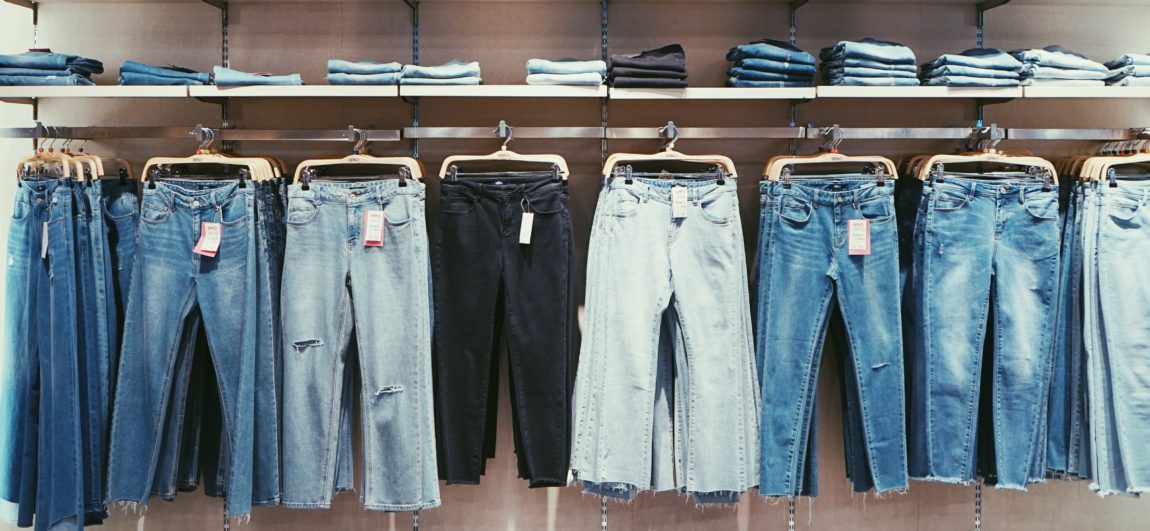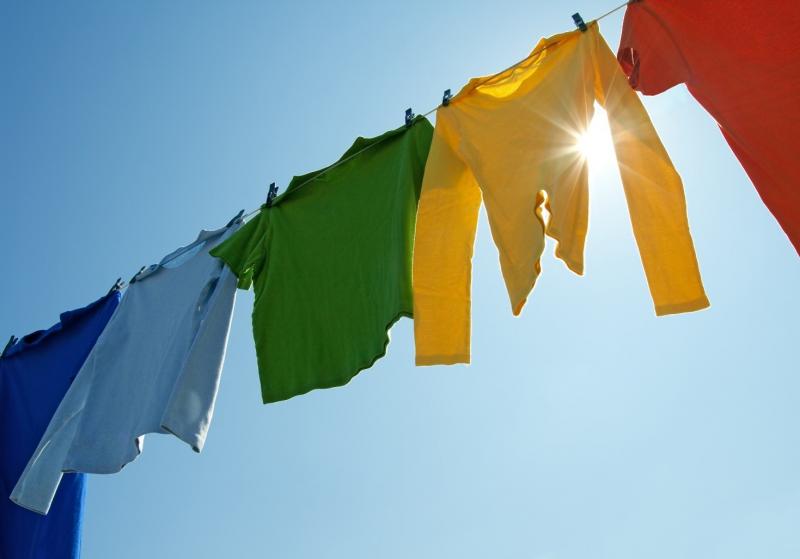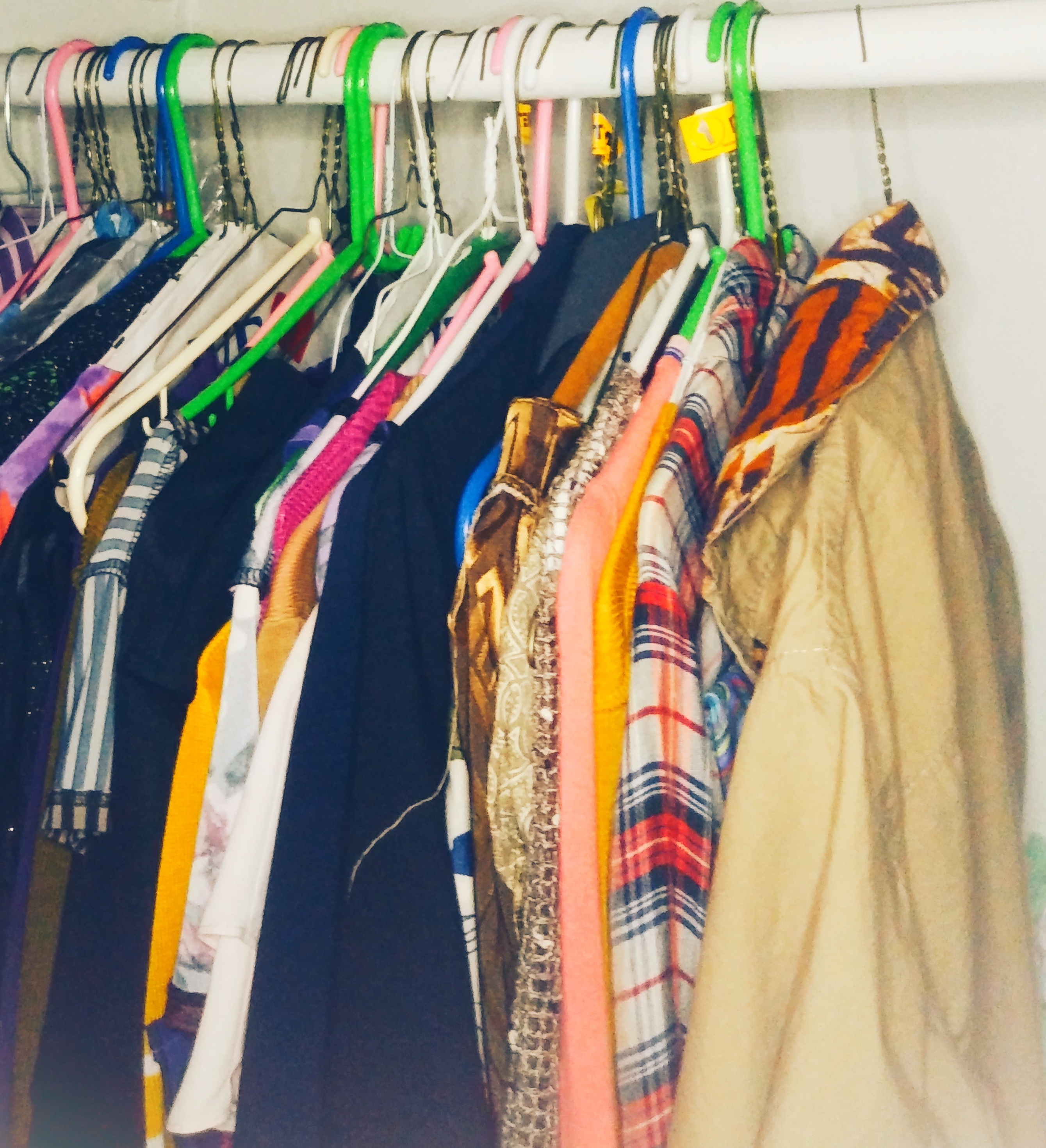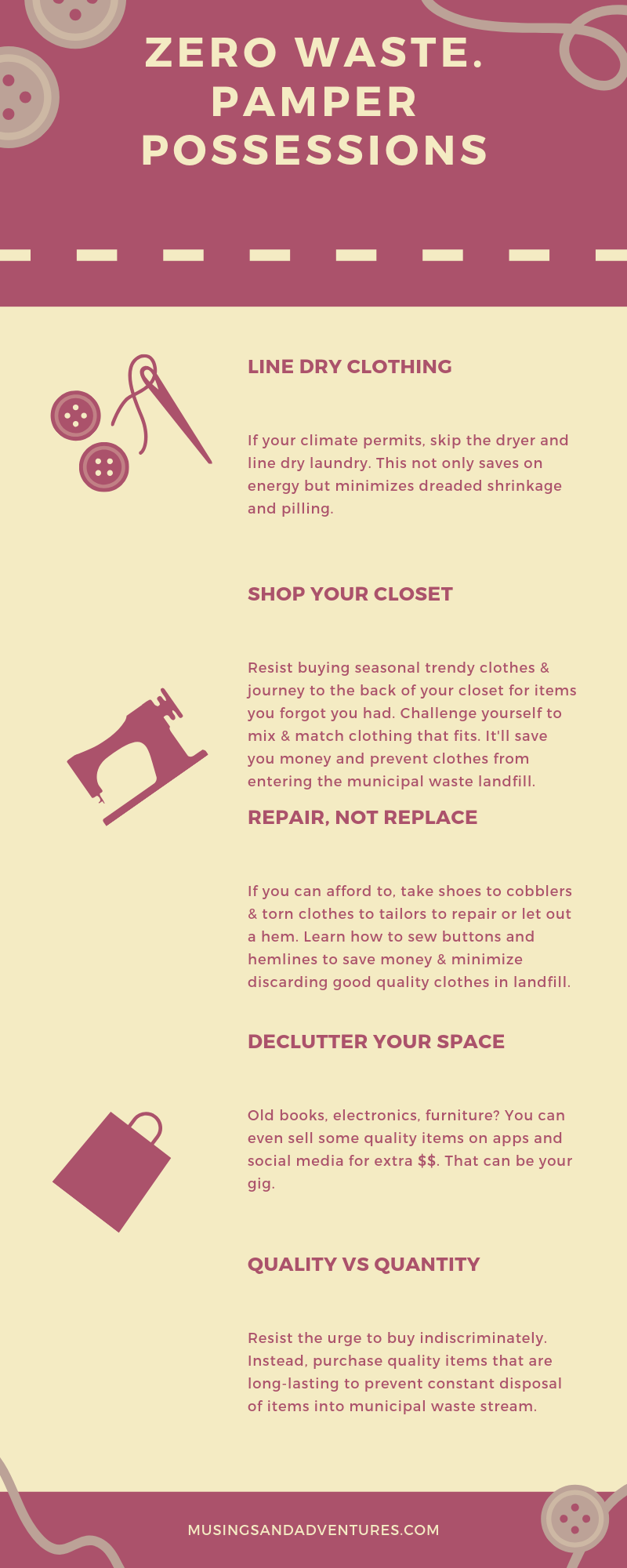*Updated in April 2019 for Earth Month.
Welcome to the penultimate post of my Zero Waste challenge undertaken in summer 2018 as part of Earth Hero’s 31 Day Zero Waste Challenge.
If I say this is easy, it’s not entirely true. Part 1 is a breeze as I already do these; part 2 is so-so – it causes me to start saving scraps for compost but I can plan ahead and bulk buy online.
Update: I compost weekly by taking my saved food scraps to a local drop-off centre and I use a free coupon to buy organic produce online but some of them come in those hard plastic shell containers. Aargh!!
Part 3, even less…I sometimes use home made cleaners of lemon slices, home made conditioner and newspaper for polishing glass, but that is it. And those are not often. Gahhh!
Now, let me see if I can redeem myself in this part of caring for current possessions.
Related: Part 1: Zero Waste Challenge – Say No To Plastic
Related: Part 2: Zero Waste Challenge – Zero Waste Cooking
Related: Part 3: Zero Waste Challenge – Do It Yourself Plastic-Free
Day 21: Line Dry Clothes
Article Contents
For anyone who smells freshly washed clothes dried to a crisp by the hot sun, that is one of the top 10 smells of childhood…or life, really.
As a child, clothes were hand washed – yes, hand washed – and line-dried, and because I grew up in West Africa, they were dry in a jiffy.
Now, dryers abound and these kids know nothing of the smell of line-dried clothing or playing hide and seek between flapping towels and sheets. Lol.
Even though there are energy efficient Energy Star rated laundry appliances on the market, it doesn’t stop shrinkage of certain material and they are heavily energy-intensive.
Living in the West, it’s not entirely impossible to replicate this if you live in warm climes year round. For those of us farther north, we get blazing sun for about 92 days a year so summer is our only option for line-drying and heat, really.
This also depends on your abode – family home as opposed to apartment building. For the latter, we make do with the convenience of in-building or in-unit laundry, if fortunate and thankfully, I am fortunate to have laundry access.
If your climes are currently warm, try line-drying in alternate weeks or months to not only save on energy consumption but protect clothes from shrinkage, dreaded pilling and annoying lint.
You also save money on new clothes and prevent the entry of discarded clothing into the municipal waste stream and landfill so win-win!
Solution: You should be hand-washing delicates – lingerie & underwear, socks, small tops & clothes that “bleed” colour to prevent their ruin during laundering. After this, air dry the small pieces on this foldable indoor line dryer where it can get some radiator heat.
Day 22: Journey to the Closet Jungle
We all know what this is: those clothes at the back of our closet that we barely remember we own – but whine that we have nothing to wear on a night out. Sigh.
Take time to re-arrange and explore your clothes and find ways to incorporate rarely worn items into the same, tired five clothing combos you wear. We’re all guilty of this. Lol.
This will slow you buying new clothes and shoes with plastic packaging and prevent used clothing going into municipal waste stream thus resulting in landfill pollution.
Solution: If you absolutely must get new clothing, make sure to donate an equal or more amount of items. For example, if I buy three new clothing items or shoes, I donate items I know I will never wear again. This is a net zero waste process.
Depending on your city, you can e-cycle clothing to prevent landfill pollution or you can donate to your local charity and get it as a tax write-off…or not.
Update: I regularly clean out my closet twice a year and any gently used items, I keep aside for re-thrifting at consignment stores. Not only do you make space in your home but you might get a couple of dollars for re-selling these items either online or at consignment stores.
Jan 2019 saw the rise of Marie Kondo as well as an uptick in donations that failed to “spark joy” for their former owners.
Day 23: Repair, Not Replace
This is the best way to go plastic-free and incorporate zero waste living into your lifestyle and home.
Growing up, it was cheaper to repair clothes, shoes, appliances and electronics countless times till they reached their umpteenth end-of-life stage – and skilled engineers still find ways to reuse or upcycle components into new material.
Shoes: In the West, it is usually cheaper to replace an item than repair it and this always baffles me. I re-soled a fave pair of flats three years ago and it cost me $40. I bought it two years prior for $29.99!
Granted, the new soles were sturdier but it cost $10 more than the cost of the shoes. When those soles wear out two years later, I sadly discard the shoes as it is not worth the cost to re-sole.
If you can re-sole footwear, by all means do so. Certain brands do it free or affordably so start emailing your inquiries. This removes clothing waste from landfills and takes you one step closer to a zero waste lifestyle.
Clothes: I’m used to fixing clothes and used to have a small sewing kit as a teen. Alas, I’ve been drawn in by convenience and just amass clothes with missing buttons and zippers for friends and family to take back home to relatives.
Clothes from consignment stores usually have minor repairs needed – missing button or tear – that can be done cheaply. This is also why clothes at said stores are very affordable and unique. I have a number of vintage items that stand out in this era of identical fast fashion clothing.
Sometimes, I go to my local tailor for a $10 zipper fix. Ouch! I wish I could use a Singer machine. Either way, I find ways to donate good condition clothes to charity or send them home where they can be repaired affordably.
Electronics: These are much harder to dispose of and cause much environmental damage because of mercury and other metals leaching into soil and groundwater in landfills.
Most people sleep outside stores for the latest gadgets – not me – to replace the current ones they just purchased six months ago. If this isn’t over-consumerism, I don’t know what is.
What then happens to these barely used gadgets? They’re either abandoned or discarded in trash. Yes, trash! People still don’t know not to discard e-waste in regular household garbage as it enters the municipal waste stream of their town or city.
Instead, contact your municipality for e-waste recyclers and their drop-off points. Many stores also provide a free drop-off for old phones, devices and computers and some brands will mail you packaging and free shipping to return the device for refurbishment.
Furthermore, if you upgrade a device on your current service plan, you can take in your old device for e-waste recycling. You have to ask first…and don’t forget to wipe data off all devices for any of these processes!
I have returned an old phone to be refurbished and I currently own an old phone that I’m re-using. Yup. I have a new phone for everything and this old smartphone for HBO, Words With Friends and back-up social media for when #1 is charging. Lol.
Day 24: Declutter Your Space
Make like a Scandinavian and incorporate minimalism into your lifestyle. That means decluttering everything from your closet to your kitchen and everything in-between.
Look through these spaces to eliminate non-functional and/or plastic items & place them for recycling or donation, if applicable. Make this a habit, say once a month or quarter, and you’ll see the amount of items that accumulate.
Once you identify them, sort items by material e.g. electronics/equipment for e-waste recycling, gently used clothes & shoes for donation, books to a library or charity, food to compost etc.
This process will declutter the municipal waste stream if everyone conducts this exercise resulting in a semi plastic-free waste stream.
Day 25: Properly Dispose of Things
We all have things that do not fit neatly into a zero waste box like “compost” or “recycle” and conventional items are from multiple components, some of which are plastic or other material.
- Paper coffee cups are lined with plastic for rigidity and while the paper is recycleable or compostable, the plastic liner is not.
- Plastic film cannot recycle but most grocery chains have a drop-off point for these.
- Sticky post-it-notes can compost instead of put in recycling.
- Wax coffee cups can compost but not recycle. Look for instructions on cup.
- Old clothing can turn into home-made rags or you can donate to clothing drop-offs where they turn into insulation material.
Take time to figure out where items to discard go based on those mini recycling cards your municipality gives out on what goes into the waste stream.
The wrong item into the wrong bin can taint the sorting process down the line thus rendering the recycling process void.
Day 26: Quality vs. Quantity
It’s safe to say that humans over-consume and Americans are in the top two consumption markets. Just because we’re trying to live a zero waste lifestyle doesn’t mean that we deprive ourselves of the finer things of life.
We just have to be mindful that items are sustainable, plastic-free and reusable at their end-of-life.
At the same time, we should shun “fast fashion” where cheap, trendy clothing is made, sold & abandoned with the changing seasons as these take us off our zero waste path into frivolity.
Do you know that the textile industry is the second most polluting after the oil industry? All the fibres, dyes and waste fabric that run off into water or end up in municipal waste streams are part of this pollution.
While we cannot shop exclusively for natural cotton or hemp fabric, we should buy quality items that can weather changing fashion seasons & hold up to time. My mum has fabric from her mum still in great condition and I’m slowly co-opting these for me lol.
Some brands allow drop-off of their old clothing and make some items from organic or recycled material. E.g. Eileen Fisher vows to use organic cotton and linen by 2020 & they re-purpose waste fibres to create yarn while some H&M clothing is made with organic, natural fibres. Madewell permits donation of any old denim at stores for upcycling.
***********************************************
I know most of us take care of our possessions because it costs to replace them but maybe we should also consider their environmental impact when it comes to the end-of-life of the items.
We can live a net zero waste and plastic-free lifestyle in our high-consuming society by incorporating elements of this zero waste challenge into every, or at least some, niche of our lives.
Don’t forget to comment and share. See you on the social streets!









23 Comments
Liz Bayardelle
November 28, 2018 at 1:18 amThis was an absolutely wonderful read! As a mom I can’t tell you how many days I walk into my kids rooms and wonder how we got to be so materialistic. What you preach about preparing instead of replacing and decluttering could not be more needed in today’s world.
admin
November 28, 2018 at 10:59 pmWe’re all guilty of that mama but we can change that. I’m very consciously changing my consumption ways and what I consume and purchase as well. Thanks a mil!
Samantha Donnelly
November 28, 2018 at 3:57 pmI am reading more and more on this, and it really does make you look and think of how you live and what you can change, I am finally winning through with my family x
admin
November 28, 2018 at 10:52 pmBravo mama!
Kristine Nicole Alessandra
November 28, 2018 at 9:38 pmThese are all great tips. I declutter regularly (once every 3 months) and donate clothes, shoes and other items. My children organize a garage sale during the spring/summer with their friends. That is the time they put up for sale their old toys, some clothes and shoes that no longer fit them.
admin
November 28, 2018 at 10:50 pmBravo!
Rhian Westbury
November 29, 2018 at 8:02 amYou’re right one of the best smells is freshly washed laundry! I think with electronics you can recycle most things which is about as good as you can get x
aisasami
December 2, 2018 at 8:44 amIn Japan, because dryers are expensive, most people hang their clothes either outside or indoors to dry. I dry outdoors on the weekends. It is sometimes a pain because you have to watch out for the elements.
admin
December 2, 2018 at 11:52 pmReally? I didn’t know that about Japan. Yeah. You do have to watch out for rain and it was always fun to do so lol
Elizabeth O
December 3, 2018 at 7:40 pmThere is a ton of wastes in the west as people discard rather than repair items. It cost more to fix zippers sometimes but it is worth the effort. Good for you for being vigilant.
Azubike Eze
June 11, 2020 at 7:55 pmYour solutions are soft on the environment. The idea to line-dry in alternate weeks or months to save on energy consumption and preserve the clothing, makes a lot of sense.
admin
June 11, 2020 at 10:35 pmWe live in temperate regions so cannot line dry 24/7/365, assuming people had the space to do so anyway.
Charlotte Petit Noble
June 12, 2020 at 3:27 amChallenge accepted. I think it is so important to be mindful of Mother Earth and question ourselves about how to protect her.
admin
June 12, 2020 at 4:12 pmExactly! There is no Planet B.
Kiara
June 12, 2020 at 6:17 pmThanks for the ideas. I’ve always been more on the sustainable side so these will fit right in with everything I’m doing.
bethan taylor-swaine
June 12, 2020 at 6:33 pmSuch good rules to live by! I try to buy quality as much as I can, often buying nearly new so that I can get it within my budget (plus I get to give the planet a little extra help!)
Monidipa
June 12, 2020 at 10:51 pmDecluttering is really important and replacing now has become must. Your solutions are really good..!
Kristine Nicole Alessandra
June 12, 2020 at 11:49 pmHere’s one more thing that we do when we declutter. We take old newspapers, magazines, and used notebooks to the recycling shop. In my country, you get some money out of it. Not a lot, but enough for the kids to get themselves a snack. They like doing this and they sometimes go over to my sister’s house to ask if she has anything she needs discarded. 🙂
admin
June 13, 2020 at 4:31 pmThat’s a great incentive to get folks to recycle!
Melanie williams
June 13, 2020 at 6:44 pmWaste is a simple problem people just need to think and be accountable for what they buy x
Marjie Mare
June 13, 2020 at 7:01 pmThis year, repair not replace was one of my goals. Thank you for sharing another inspirational post.
admin
June 14, 2020 at 6:21 amI’m glad you found it useful, Marjie. I hate waste too.
Clarice
June 13, 2020 at 7:32 pmYour zero-waste initiative is truly inspiring. I agree that using a line dryer is a better option. We actually use a foldable indoor line dryer at home.